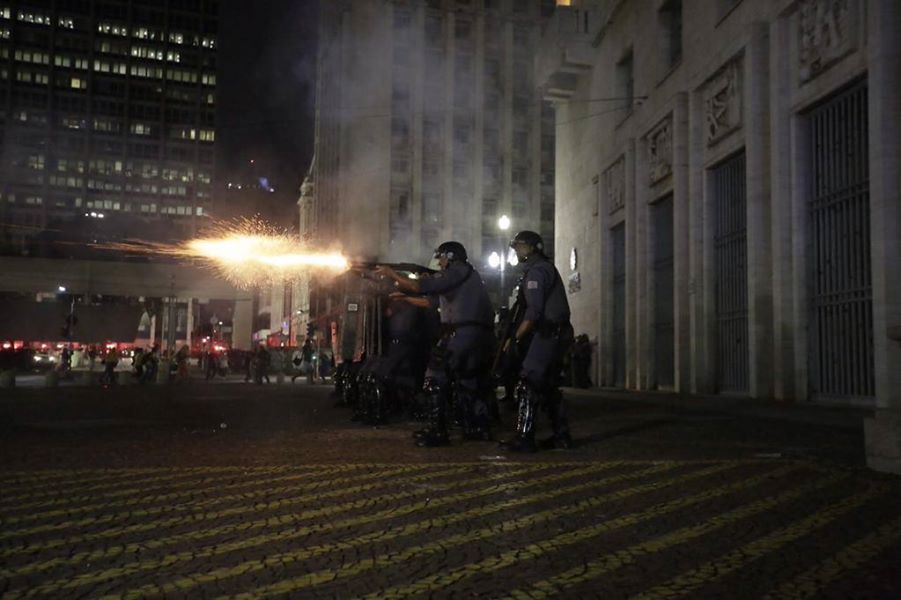
Police shoots stunt grenades, tear gas bombs and rubber bullets in front of the City Hall in São Paulo, January 16. Photo by Felipe Larozza/MPL, usage is free.
A second demonstration against the rise in bus, subway and train fares organized by the Free Pass Movement (MPL) in São Paulo, Brazil on January 16, once again ended in violence.
A total of 20,000 people gathered for the protest, according to the organizers (2,000, according to police). From the very beginning of the demonstration, tension was present with at least 1,000 police officers surrounding the protesters. Independent media collective Mídia Ninja described the scene:
Até as 20h33, a manifestação vinha bem, apesar de a PM ter detido um manifestante pelo “pecado” de carregar uma rodinha de skate na mochila. Jogaram-no no chão como a um saco de lixo, imobilizaram-no. Logo ele foi solto. Também explodiu um artefato de gás lacrimogêneo na frente do Ministério do Trabalho, na rua da Consolação 1272…
Mas a passeata seguiu firme e organizada, apesar de duas agências bancárias (uma da Caixa Econômica Federal e outra do Banco do Brasil) terem sido depredadas não se sabe nem por quem.
Era alta a tensão reinante.
Until 20:33, the demonstration wore on without incident, despite the fact that the military police arrested a protester for the “sin” of carrying a skateboard wheel in his backpack. They threw him to the ground like a bag of garbage, immobilized him. Soon he was released. [Police] [a]lso blew up a tear gas device in front of the Ministry of Labour, on the street of Consolação 1272 …
But the march continued on, resolute and organized, despite two bank agencies (the Caixa Econômica Federal and the Banco do Brasil) being vandalized by unknown people.
It was the reigning high tension.
Website Ponte recorded and posted a video of the moment a protester, Osvaldo Carvalhosa, was arrested at Consolação street. Still, despite the few bombs and the tear gas, the demonstration remained calm and walked towards the City Hall. That was when real clashes began.
A video of the protest marching at Consolação street was published by YouTube user k4rshh:
Journalist Fausto Salvadori recorded and posted on his Facebook a video of the police throwing stun grenades, tear gas bombs and rubber bullets against those who were gathered in front of the City Hall:
Isso aconteceu a poucos metros de nossa equipe, que quase foi atingida pelas primeiras bombas. A versão da @PMESP, portanto, é falsa. — (@PodemosMaisBR) 17 janeiro 2015
This happened a few meters from our team, which was almost hit by the first bombs. The military police's version is therefore false.
Many videos are coming to light with scenes of violence perpetrated by the police. Collective Território Livre published a photo of a demonstrator who was shot in the eye with a rubber bullet.
Journalist Charles Nisz also tweeted:
Alguém jogou uma garrafa plástica no escudo do Choque. A PM respondeu com bombas de gás. Dworkin chamaria de falta de proporcionalidade — (@charlesnisz) 16 janeiro 2015
Someone threw a plastic bottle at the shield of the shock [batallion]. The military police responded with tear gas. Dworkin would call it lack of proportionality
Magazine Carta Capital reported it was actually a beer bottle thrown at a police officer's shield. Police Marshall Victor Fedrizzi stated that a “rojão”, a type of firework, was launched at the police, though some witnesses say that police bombs preceded any fireworks.
Activist Bruno Bonsanti tweeted:
Uma garrafa, bombas. Isso, certinho, totalmente proporcional. — (@brunobonsanti) 16 janeiro 2015
A bottle, bombs. Yes, just right, fully proportional.
Website Ponte recorded a short video of people running to escape the police and denounced that they were attacked with pepper spray while trying to approach a woman who had passed out from the fumes. On the other hand, journalist Ben Taverner condemned the use of a molotov cocktail by a protester:
Molotov c'tails, fireworks & glass thrown at police who respond with tear gas and stun grenades. Arrests made pic.twitter.com/7EyHG4oNqA — Ben Tavener (@BenTavener) 16 janeiro 2015
He caught on video the moment when what is believed to be a molotov cocktail is thrown at the police. When watched in slow motion, it's possible to see that the police starts shooting (possibly stun grenades and tear gas) before the alleged homemade bomb hits the ground.
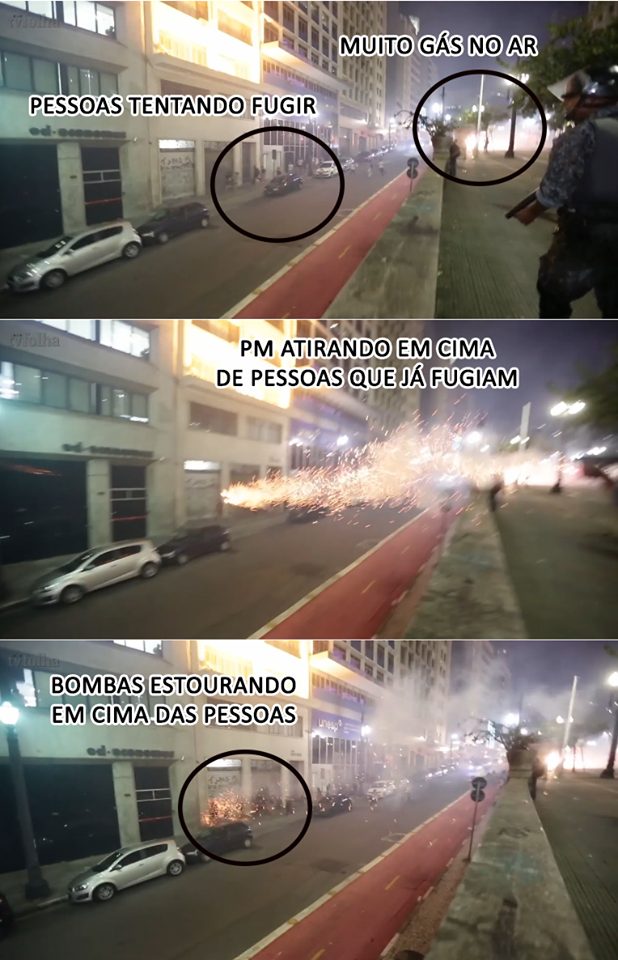
Stills of a video (link on the end of the post) showing people running in the streets and being targeted by the police.
He also added on his blog:
The MPL said it believed at least 13 people were arrested, and that police had prevented lawyers and legal observers from carrying out their duties. Police had not yet disclosed final arrest tallies at the time of writing.
The protest movement later accused the police of targeting protesters disproportionately with “gratuitous attacks”, but police released video that purported to show protesters attacked police first.
The military police's official Twitter account stated fireworks were shot against them and their police cars. On the other hand, journalist Jessica Santos argued:
Eu não estava na Prefeitura, mas estava no teatro e só escutamos fogos de artifício depois de pelos menos 4 ou 5 bombas. Então fica difícil considerar que foram os fogos que motivaram a ação.
I wasn't at the City Hall, but was at the theater and [we] only heard fireworks after at least 4 or 5 bombs. So it is difficult to assume that these were the fireworks that led to action.
Journalist Pedro Zambada agrees with Jessica, stating that “The bombs of the Military Police detonated first. Because they didn't want us to get to the Secretariat of Transport”. Other sources agree.
PSTU (Unified Socialist Workers Party) posted a video on its YouTube channel with scenes of the police repression in front of City Hall:
Professor Eduardo Sterzi accused the police of using violence against citizens and asked for the abolition of the military police:
Se vocês pudessem ver o desespero de uma mãe, com sua filha de uns cinco anos, ambas chorando muito, tentando fugir das bombas dessa polícia covarde, entenderiam que não basta desmilitarizar esse bando de assassinos. É preciso extinguir a instituição e punir seus integrantes e mandantes.
If you could see the desperation of a mother with her daughter about five years old, both crying a lot, trying to escape this coward police's bombs, you would understand that demilitarizing his murderous gang is not enough. We must extinguish the institution and punish its members and leaders.
Collective Ocupa Sampa jokingly tweeted:
Muita bomba! Policia ataca novamente a manifestação. É bomba democratica para dispersar a revolta popular. #contraTarifa #passeLivre
— Ocupa Sampa (@OcupaSampa) 16 janeiro 2015
A lot of bombs! Police again attacked the demonstration. It's democratic bomb to disperse the popular uprising. #AgainstFare #FreePass
- Ocupa Sampa (OcupaSampa) January 16, 2015
Both professor Pablo Ortellado and the MPL accused the media, specifically São Paulo's two biggest newspapers Folha de São Paulo and O Estado de São Paulo, of criminalizing demonstrators, just like in 2013, when their own journalists were targeted and wounded:
Folha e Estado: vocês são cúmplices da violência da polícia.
— Pablo Ortellado (@pablo_ortellado) 17 janeiro 2015
Uma parte da responsabilidade pelos ataques gratuitos da PM à manifestação está na conta da Folha e do Estado. #ContraTarifa
— MPL – São Paulo (@mpl_sp) 16 janeiro 2015
Os dois jornais de São Paulo escreveram artigos defendendo e autorizando uso ainda mais “incisivo” pela PM contra manifestantes hoje.
— MPL – São Paulo (@mpl_sp) 16 janeiro 2015
É importante lembrar que fizeram exatamente a mesma coisa em 2013, na véspera da manifestação em que PMs atiraram até mesmo em jornalistas.
— MPL – São Paulo (@mpl_sp) 16 janeiro 2015
Folha and Estado you are accomplices of police violence.
- Pablo Ortellado (pablo_ortellado) January 17, 2015
Part of the responsibility for the free Military Police attacks to the demonstration is in the account of Folha and Estado. #AgainstFare
- MPL – São Paulo (mpl_sp) January 16, 2015
The two newspapers of São Paulo wrote articles advocating and empowering the use of even more “incisive” by the PM against protesters today.
- MPL – São Paulo (mpl_sp) January 16, 2015
It's important to remember that they did exactly the same thing in 2013, on the eve of the demonstration in which the Military Police shot even journalists.
- MPL – São Paulo (mpl_sp) January 16, 2015
However, a video recorded by TV Folha, from the same media group mentioned above, Folha de S. Paulo, showed that since the beginning the intention of the military police was to brutalize those at the demonstration:
Due to the violence of the military police in the previous demonstration, that ended with the temporary arrests of more than 50 protesters, the civil police will investigate the military police for torture and abuse of power.
Just like after the first demonstration, Fabio Malini, a professor and activist, published on Facebook a graphical analysis of thousands of tweets about the protests. More photos of the demonstration and of the police brutality can be seen at Midia Ninja's web page. Another demonstration, on the 20th, gathered 8 thousand people and ended up peacefully, but the 4th one, on the 24th was again attacked by the Military Police.

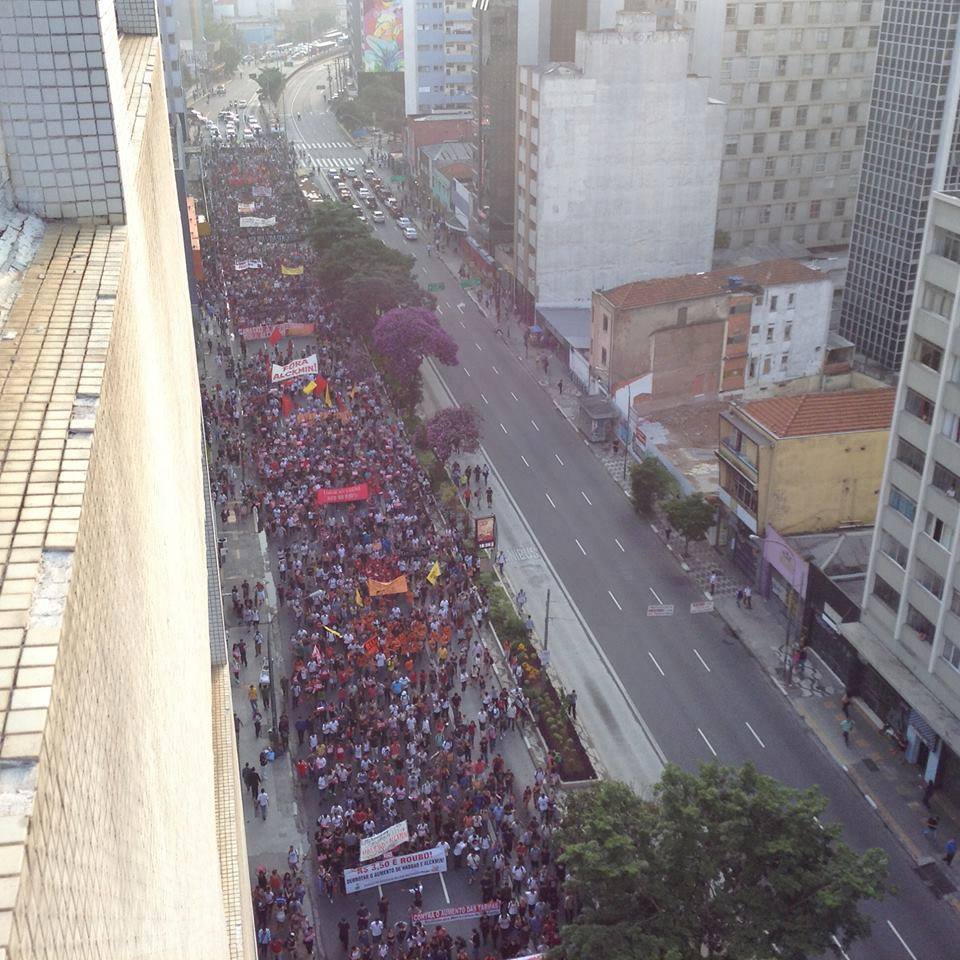
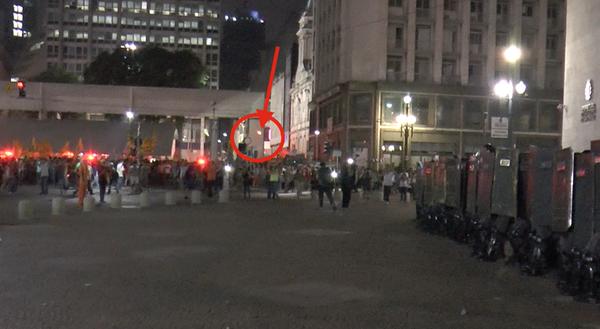
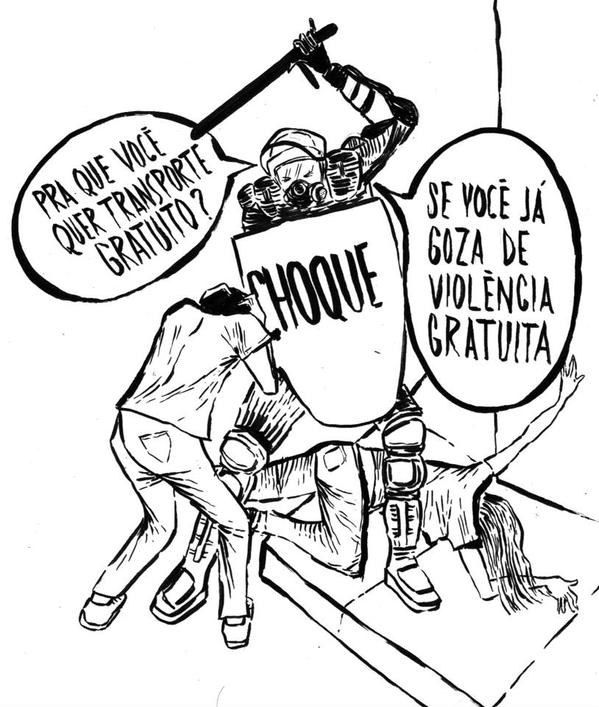






2 comments
Sobre a garrafa plática, em 2:40.
Não sei se dá pra concluir algo com absoluta certeza, mas aí está:
https://www.youtube.com/watch?v=0-oVv6bVDQ0
Sem dúvida é suspeito. A PM já usou P2 no Rio pra jogar molotov contra a própria tropa, logo, o mais certo é pensar que a própria PM novamente começou a violência.